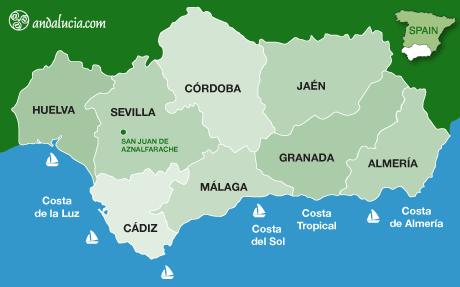SAN JUAN DEL AZNALFARACHE
by Saskia Mier
San Juan del Aznalfarache is most well known for being the location where the headquarters of RTVA (Radio and Television of Andalusia), also known as Canal Sur, was established. It has about 21, 500 inhabitants.
HISTORY
Due to the privileged raised situation of San Juan del Aznalfarache, it was a very important settlement especially during the Turdetan and Roman eras, highlighting the existence of Lake Ligustino in the lower Guadalquivir area, where trade was carried out with Phenicia, Roman Greece and Carthage.
The origin is said to date to around the third century A.C. Already in the first century texts of Pliny, the Turdetan Oppidum of Osset is highlighted, located opposite Hispalis. There is documented existence of an industrial complex dedicated to the manufacture of wine in the area.
As from the reign of Augusto, the Oppidum is transformed into a Roman settlement known as, Osset Iulia Constantia. As from the Islamic occupation, there is data of the existence and continuity of the municipality in the eleventh century, when Taifa King, Al-Mutamid, ordered the construction of a summer palace.
At the end of the second century, between 1193 and 1197, the Almohad Caliphate, Abu Yusuf al-Mansor, had a fort built here and called it Hins al-Faray. The fortress also had a palace and a new neighbourhood was built on the southern slope, this being the origin of San Juan Bajo.
During the Almohad period, the fortified area was expanded joining the northern and southern hill, uniting the Roman and Almohad areas with a monumental door that that led to Hispalis.
In 1243, it was handed over to the Military Order of San Juan of Jerusalem, later passing on to the Carthusians and Franciscans.
THINGS TO SEE
Casa de las Minas de Cala
The house belonged to the director and offices of the mining railway Cala-San Juan. It is one of the most representative civil monuments of San Juan de Aznalfarache because it is a symbol of the industrial past of the municipality. The history of this railway ended definitively in 1960, victim of the economic unfeasibility, and materials, except real estate, were auctioned between that year and 1965. The house ceased to be used and experienced a rapid deterioration. In 1984 it was handed over to the Junta de Andalucía. In August 1988 a fire devastated almost all of its structure. The restoration was directed by architects, Ramón Gómez Bustillo and Alfonso Guajardo-Fajardo Ibarra, completed in four stages; in 2007, 2008, 2009-2010 and 2010-2011. Located on Calle Minas de Cala.
Capilla de Nuestra Señora del Rosario
The Baroque chapel dates to the eighteenth century. Located on Calle Real.
Iglesia de los Sagrados Corazones
The church formed part of a Franciscan convent and at present, is attached to the monumental complex dedicated to Corazón de Jesús. Located on Paseo del Mirador.
Iglesia de San Juan Bautista
The Neo-Mudejar style church has altarpieces, images and canvases from the seventeenth, eighteenth and nineteenth centuries. Located in Plaza de San Juan Bautista.
Murallas Hins-Alfaray
The remains of the Almohade fortess, built by Abu Yusuf al-Mansor. Located in Barriada El Monumento.
Centro de Interpretacion del Patrimonio Arqueologico de San Juan de Aznalfarache
The Centre allows the visualization of archaeological remains of the Turdetana, Roman and Moorish eras. The Turdetans built a winery, while the Romans transformed this space into a public square with a perimeter wall, from which remains of the wall have been preserved. Later, during the Almohad settlement, the Moors took advantage of the Roman building to build a fortified area, which includes two towers from which they controlled access from the Vega de Triana to the ancient Osset (San Juan de Aznalfarache). Located in Plaza del Doctor Muñoz Cariñanos.
Opening Times:
Wednesday and Friday, 10:00-13:00hrs
Tuesday and Thursday, 17:00-19:00hrs
Sabado, 11:00-19:00hrs
Tuesday, Wednesday and Thursday, 10:30-13:00hrs (July)
Tel: 954 76 98 86 and 659 93 92 51
Price: Adults, 2.00 euro. Children (under 16), 1.50 euro. Group with a guide, 20 euro.
HANDICRAFTS
Traditional crafts include ceramics, saddler, forgery and embroidery.
GASTRONOMY
Dishes to try in San Juan del Aznalfarache include gazpacho, cocido con pringá (meat stew) and arroz con perdiz (rice with partridge). One must remember that San Juan forms part of the famous Ruta del Arroz (Rice Route).
FESTIVALS
Cabalgata Reyes Magos
Three Kings procession celebrated on the evening of 5 January.
Fiesta Virgen de la Paz
Celebrated the 24 January.
Carnaval
Celebrated in February.
Semana Santa
Holy Week.
Fiesta San Juan Bautista
Celebrated the 24 June.
Fiesta Virgen del Carmen
Celebrated the 16 July.
Fiesta Virgen del Rosario
Celebrated the third Saturday of October.
Fiesta Virgen del Carmen
Celebrated the 1 November.
NEXT PLACES
The next villages to San Juan del Aznalfarache are Mairena del Aljarafe, Tomares and Coria del Río.
San Juan de Aznalfarache - Hotels
Book hotels in San Juan de Aznalfarache

